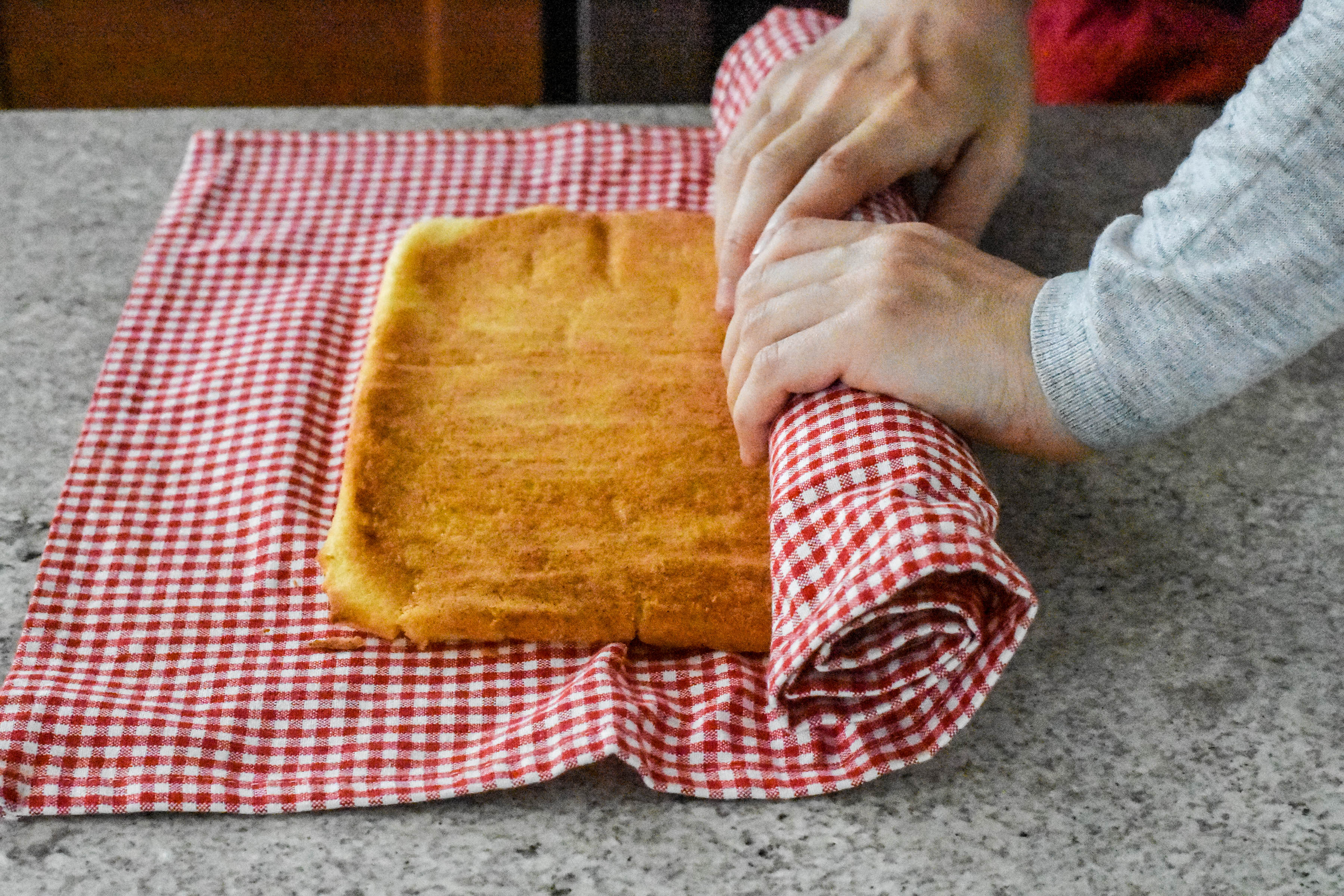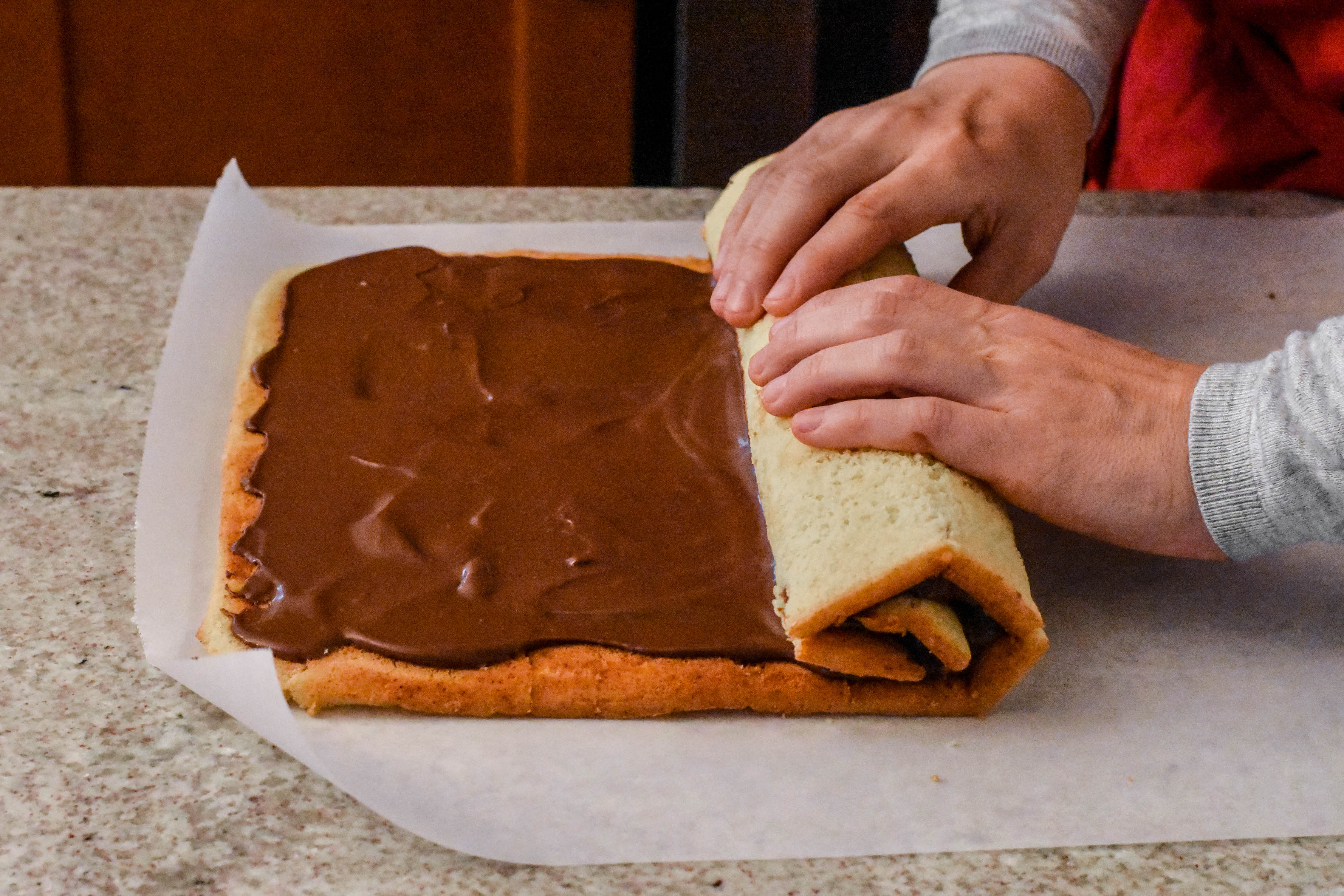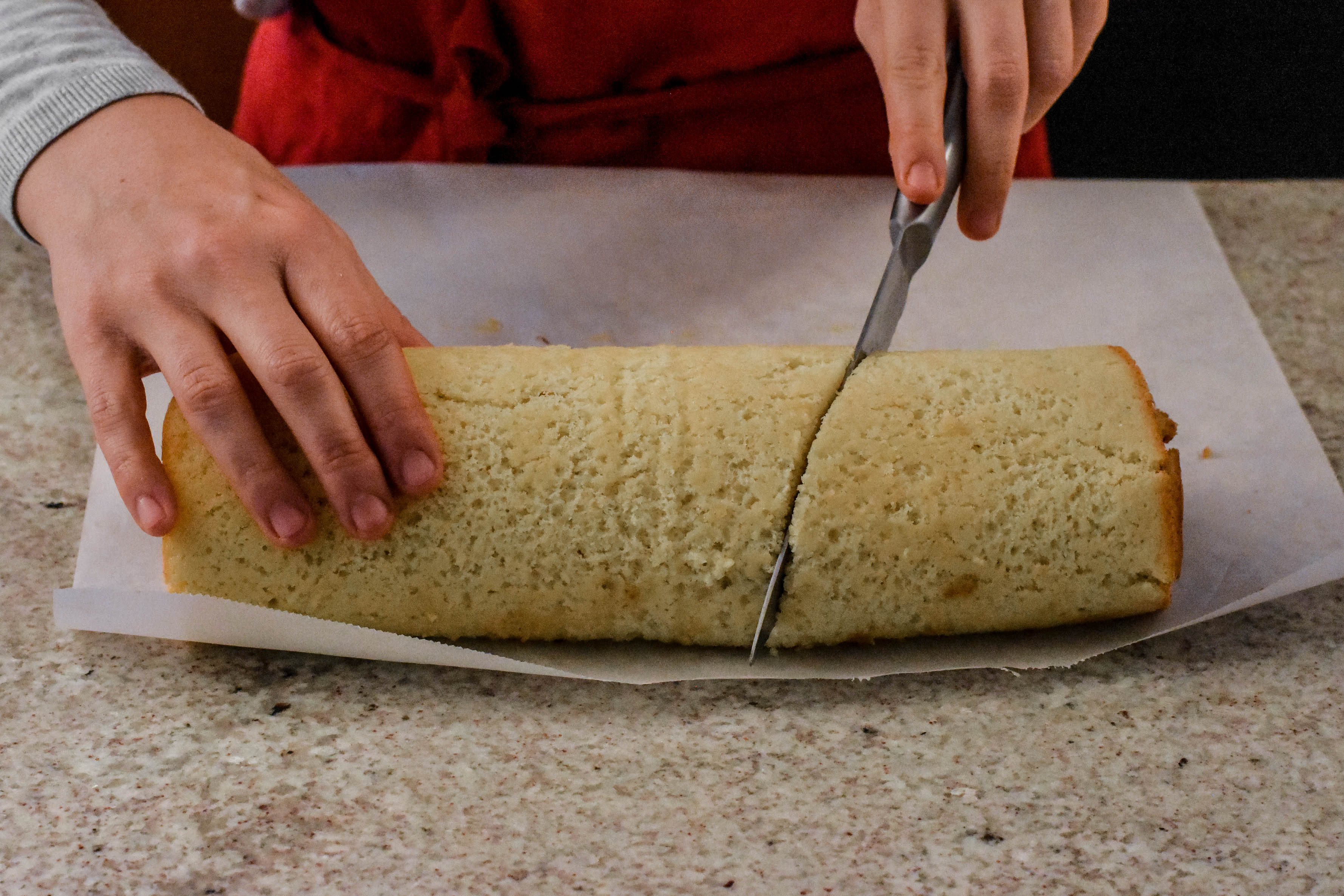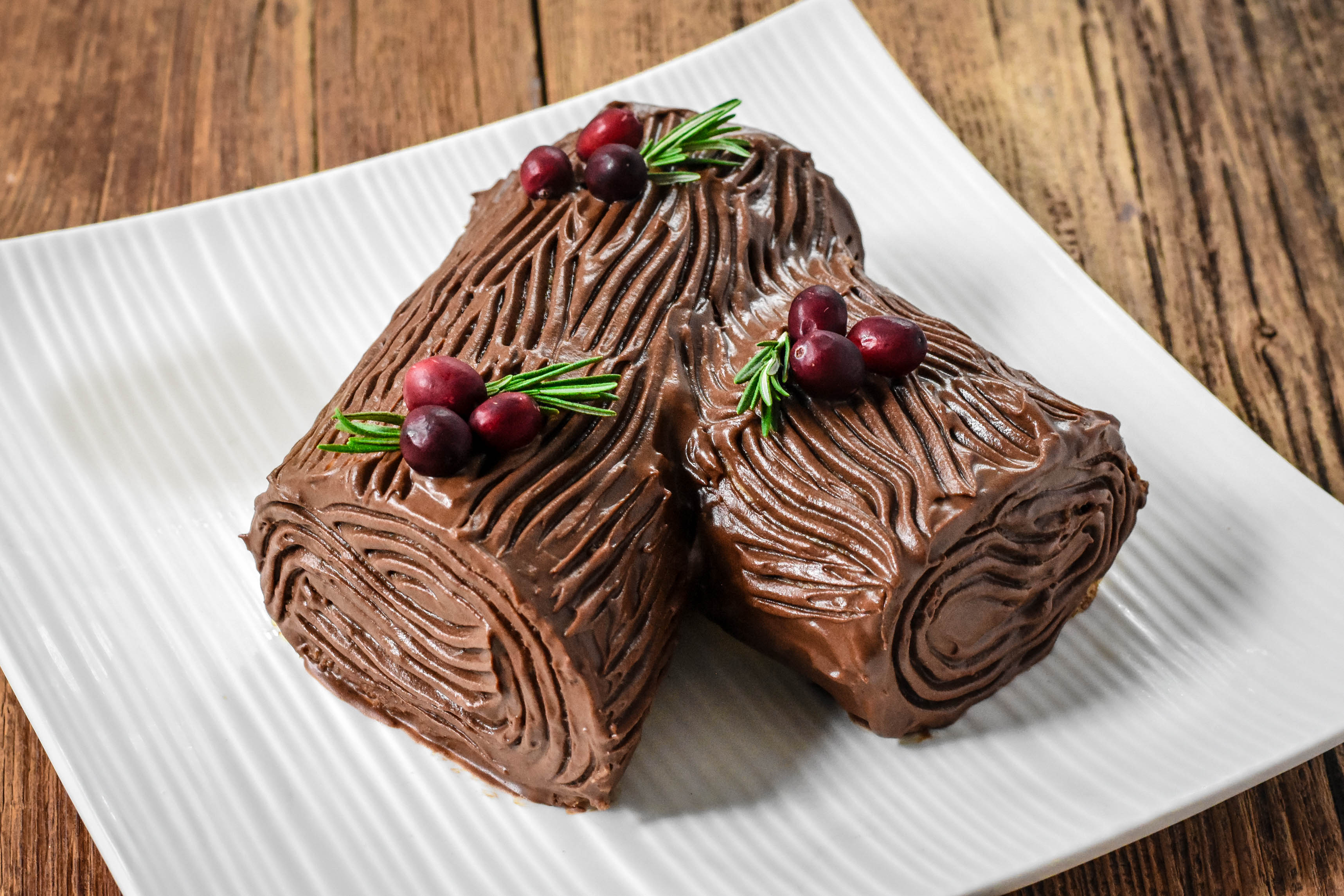BY
In France, a proper Christmas dinner wouldn’t be complete without the bûche de Nöel. This wooden log look-a-like cake, traditionally made of a rolled genoise cake filled and frosted with buttercream, is part of the official conclusion to a Christmas feast.
It’s a holiday ritual no one would pass on—even with an overfilled belly.
Festive Origins
The tradition of the Christmas Yule log—an actual log, not the cake—stretches back to more than 2,000 years ago, before the Medieval era. People in Scandinavian, Germanic, and Celtic countries would celebrate the winter solstice by selecting and cutting a log, bringing it back to their homes, and burning it in their hearth throughout the longest night of the year.
In different countries and families, the choice of the wood (cherry, oak, or birch), the size of the log, and the manner in which it was lit were of utmost importance. This ritual, a huge part of the celebratory traditions in these households, was a way to welcome the new year and bring fortune for the whole family.

Around the 12th century, the tradition was adopted by the Catholic Church. To add religious symbolism to the ritual, logs were sprinkled with holy water before being burnt. The fire then needed to be nurtured to last 12 days, from Christmas Eve until the Epiphany.
This tradition remained as such until about the 19th century. It then slowly vanished with the disappearance of the large hearth within homes, as many people moved to smaller urban houses.

From the Hearth to the Oven
With no fireplace to burn in, logs were instead symbolically placed on mantles as decoration. Later, in the late 1800s, the first Yule log as a decorative cake was invented—with various French bakers all fiercely claiming credit for its invention, of course.
This simple, light and fluffy, rolled dessert stood in stark contrast with other common French Christmas desserts of the time, which tended to be overly rich and dense, packed with dried fruits and nuts—closer to the British Christmas pudding or German stollen. It was quickly adopted amongst French households, and by the end of the 20th century, had also caught on in other francophone countries, such as Belgium, Switzerland, and even Quebec, Canada.

Today, the French’s appetite for the classic Christmas dessert remains alive and well. Every year, bakeries and pastry chefs all around the country kick off their efforts to create their most unique bûche as early as October, always coming up with new flavors and elaborate decorations to distinguish themselves from other bakers. Berry, chestnut, or coconut cakes adorned with gnomes, mushrooms, and pine trees are just a few examples.
With such an incredible selection available at every corner bakery, few people in France make their own bûche de Nöel at home anymore. Outside of France, though, finding one may not be the easiest of tasks. But creating your own at home is far easier than you may think.
It will take two to three hours of your time, depending on your baking abilities, but I guarantee that the process will be fun and rewarding, and leave you with a stunning, festive centerpiece for your holiday table.

Making Your Own Bûche at Home
Despite its elaborate appearance, this traditional bûche de Nöel is a simple combination of two elements: a light vanilla genoise sheet cake, rolled into a cylinder, and a rich dark chocolate buttercream, spread both inside and outside of the roll.
The bûche is presented with one end of the cake cut off and re-attached to the side, to resemble a branch, before the “log” is entirely covered with buttercream.
Take the process step-by-step: first the genoise cake, then the chocolate buttercream, and finally the assembly. To ease you into the recipe, here are a few handy tips:
For a Seamless Sheet Cake
The trick to preventing cracks in a rolled Genoise cake (or any Swiss roll cake) is to roll it right out of the oven, while it’s still warm, in a clean kitchen cloth dusted with sugar. This keeps the cake moist and allows it to “memorize” its rolled shape as it cools. When the cake is cool, gently unroll it, immediately spread the buttercream into it, and roll it back up.

For a Fluffy, Spreadable Buttercream
Not to be confused with a typical American buttercream, this French chocolate buttercream is made with egg whites, sugar syrup, and a generous amount of butter, whipped gradually into a fluffy chocolate meringue. The butter should be soft (at room temperature) to be properly incorporated, yet not too soft, or else the buttercream will be runny. If the buttercream becomes too fluid, pop the bowl into the fridge until it has chilled through.
For a Realistic Finish
Once the cake is covered with buttercream, drag a fork along the outside to make it look like tree bark. It doesn’t have to be perfect; the more rustic the better.
For Decoration
For the finishing touch, a bûche de Nöel is traditionally dusted with powdered sugar, to resemble snow, and dotted with meringue mushrooms, to match the woodsy theme. You can also get creative and use ingredients you may already have in your kitchen, such as fresh cranberries and rosemary sprigs to resemble mistletoe.

Classic Bûche de Noël (Yule Log Cake)
Serves 8 to 10
For the genoise cake:
- 1 cup all-purpose flour
- 1 teaspoon baking powder
- 4 large eggs
- 1 cup sugar
- 1 1/2 teaspoon vanilla extract
- 3 tablespoons butter, melted and cooled
For the dark chocolate buttercream:
- 7 large egg whites
- 1/2 teaspoon salt
- 1 1/4 cup sugar
- 6 ounces dark chocolate, melted and cooled
- 1/2 teaspoon vanilla extract
- 1 1/2 cup unsalted butter, softened
For the decoration:
- 8–10 cranberries
- 8–10 fresh rosemary sprigs
- Powdered sugar
For the genoise cake: Preheat your oven to 375 degrees F with a rack in the middle. Butter a 10 x 15-inch rimmed baking sheet and line it with parchment paper. Butter the parchment or spray it with cooking spray. Set the pan aside.
In a large mixing bowl, sift together the all-purpose flour and baking powder.
In a separate bowl, beat the eggs until thick and foamy, about 5 minutes. Add the sugar and vanilla, and beat for 2 more minutes.
Gently fold the flour into the wet ingredients and stop mixing when just incorporated. Slowly pour the melted butter into the batter while still mixing, and stop again when just incorporated. Gently spread the batter into the prepared pan and smooth it out with a spatula so it covers the whole pan.
Bake for 12 minutes, until a toothpick inserted in the center of the cake sheet comes out clean. Immediately sprinkle a clean kitchen towel with powdered sugar and flip the cake onto it. Peel off the parchment paper and roll the cake in the kitchen towel, starting from the narrow (shorter width) side. While the cake cools to room temperature, make the buttercream.
For the dark chocolate buttercream:In a large mixing bowl, beat the egg whites on high speed until soft peaks form. Set aside.
In a small saucepan, combine sugar with 2/3 cup water over medium heat. Bring to a boil and reduce the liquid by half, or until it has thickened to a thin syrup consistency.
Start beating the egg whites on high speed again and slowly pour in the syrup. Continue beating and pour in the melted dark chocolate and vanilla extract. Continue beating until the mixture has completely cooled, about 5 minutes. Add the softened butter, one tablespoon at a time, beating well between each addition until the butter is fully incorporated.
Once all the butter is incorporated, the buttercream should be fluffy and spreadable. If too soft, refrigerate for one hour, until it has chilled through.
To assemble: Unroll the cake sheet and transfer it carefully onto a working surface. Evenly spread half of the buttercream, about 2 1/2 cups, onto the entire cake sheet. Re-roll the cake into a log, as it previously was.
Using a large serrated knife, cut off a quarter of the cake-log on a diagonal. Attach that cut piece to the new center of the cake with buttercream, to resemble a branch bulging from a tree log.
Transfer the cake to a serving plate and use the remainder of the buttercream to cover the log entirely. Smooth it out with an offset spatula. Take a fork and run its tines along the outside of the log to leave streaks resembling the grooves of tree bark. Adorn the log with cranberries and rosemary sprigs.
Chill the cake for at least 2 hours before serving, to allow the buttercream to set. Dust with powdered sugar right before serving.
Audrey Le Goff is a French food writer, photographer, and creator of the food blog Pardon Your French, where she shares recipes and stories from her beloved home country, France. She is the author of the cookbook “Rustic French Cooking Made Easy” (2019). She currently lives in Niagara, Canada. Follow her on Instagram @pardonyourfrench
Republished with Permission The Epoch Times SUBSCRIBE
Get Citizensjournal.us Headlines free SUBSCRIPTION. Keep us publishing – DONATE




